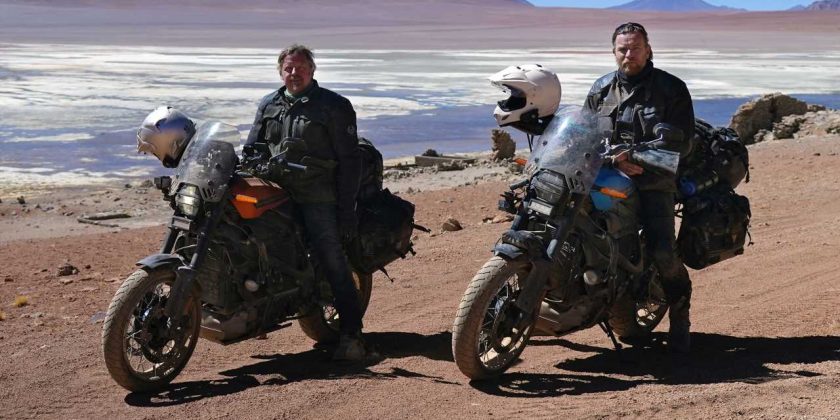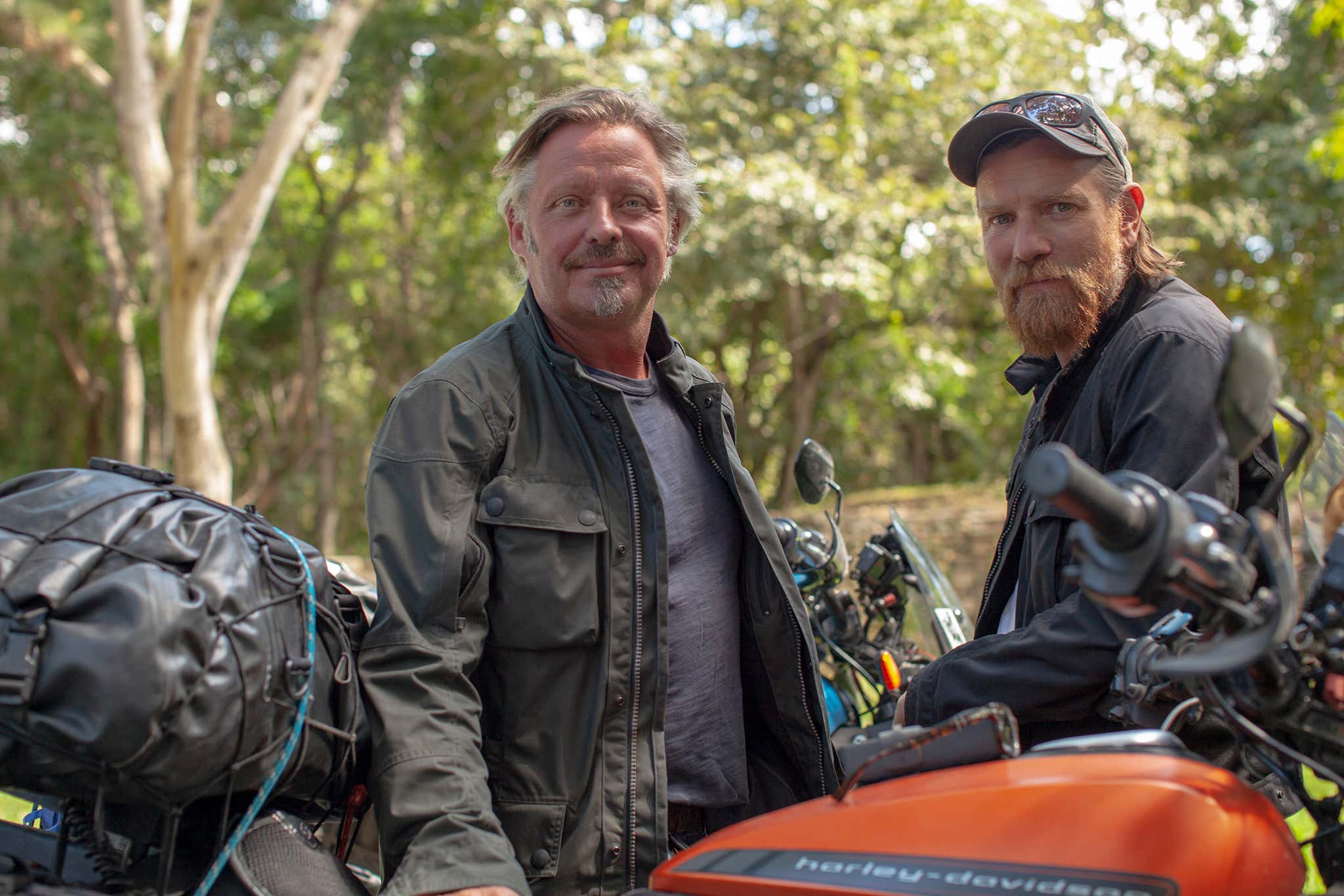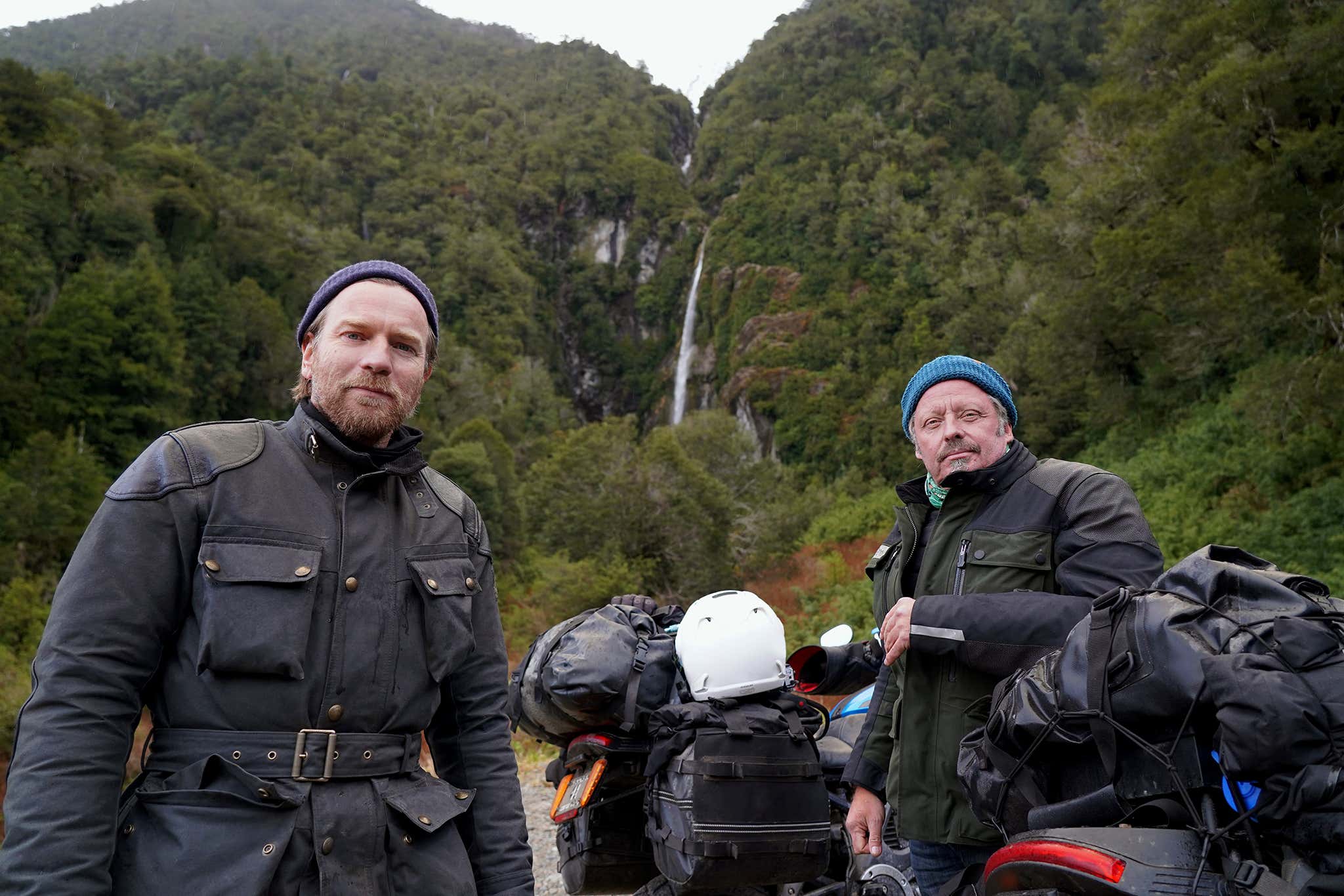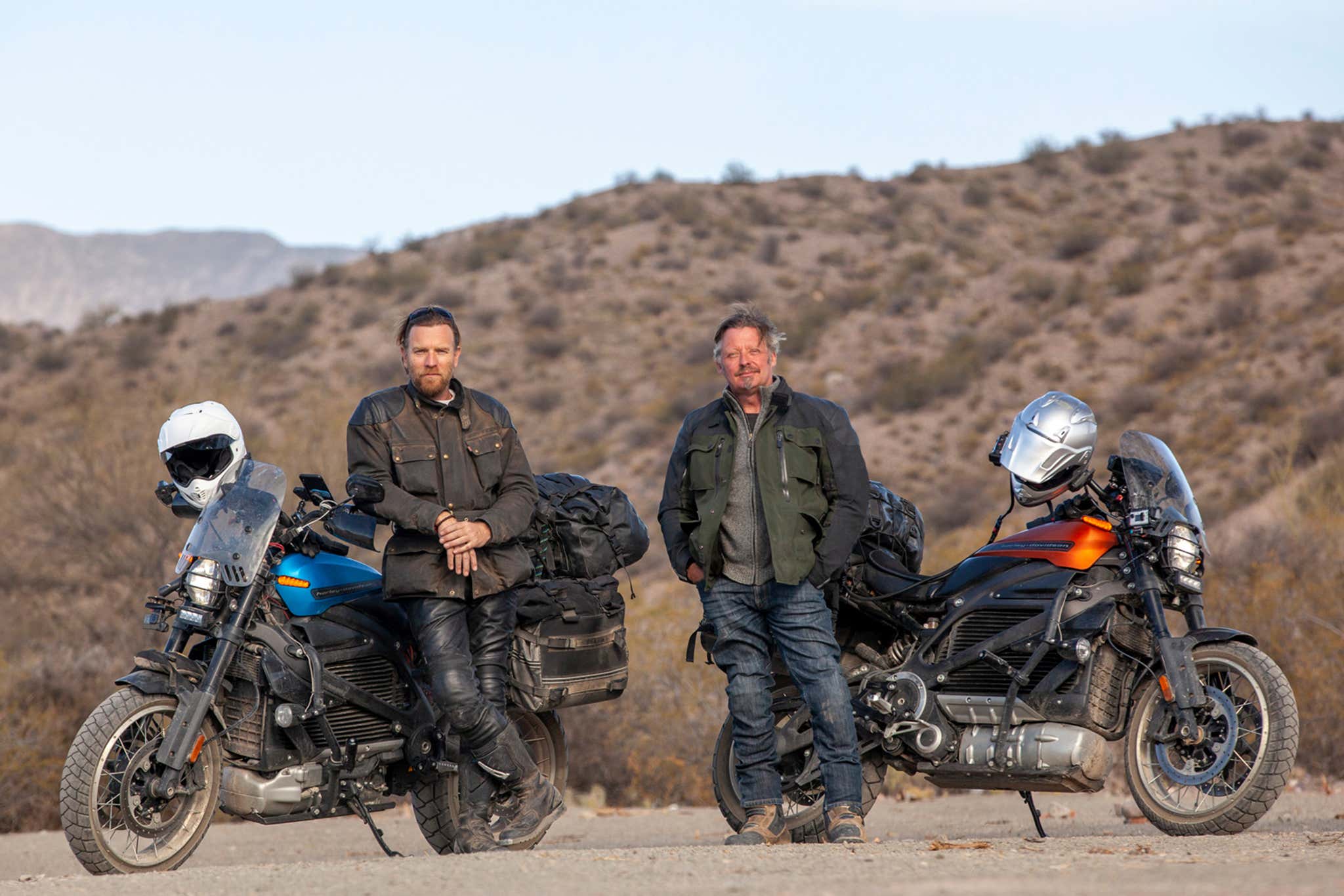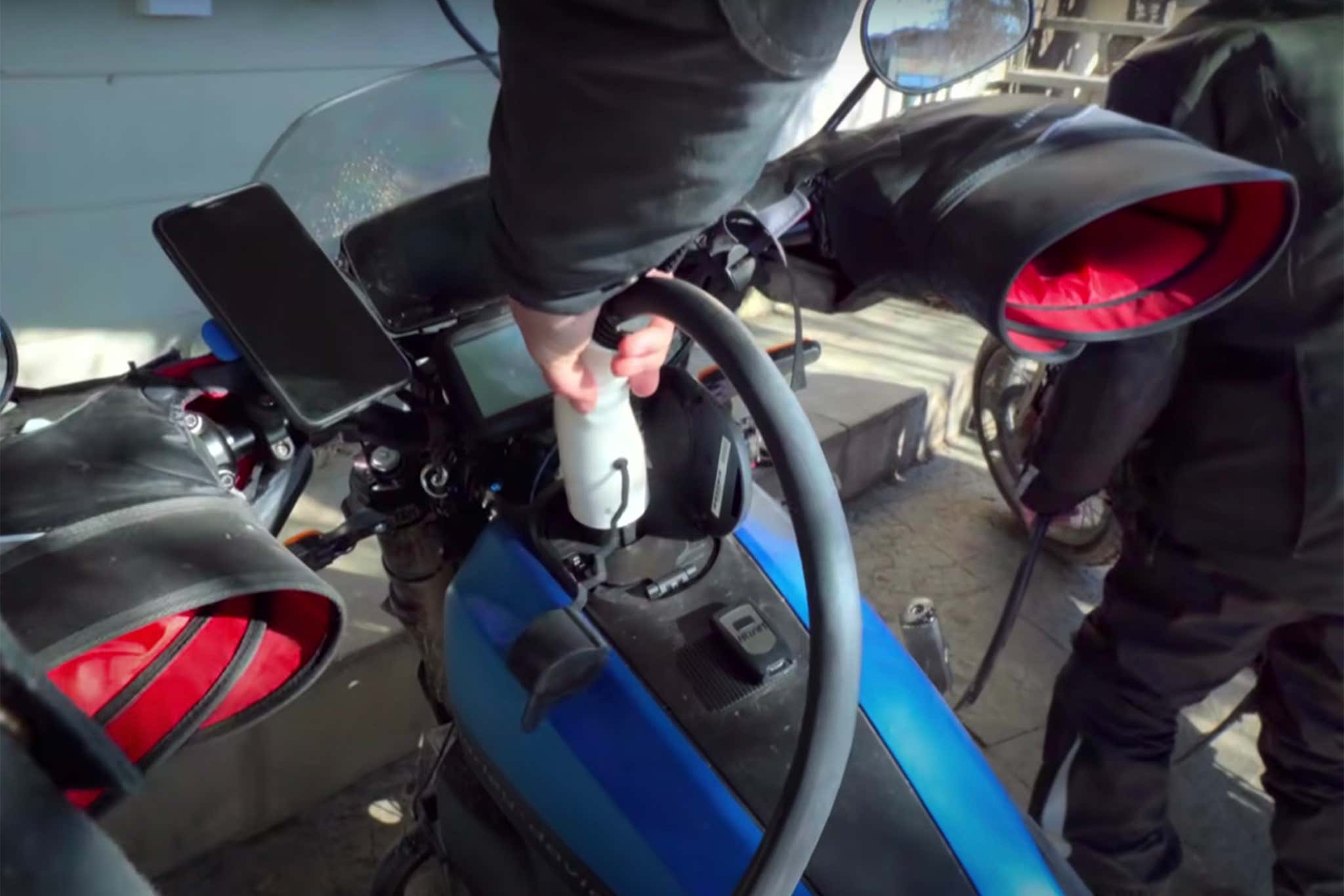Once you’ve been around the world and down its length on a motorcycle, there really isn’t anywhere left to go but up. So it goes with Ewan McGregor and Charley Boorman and their third globe-trotting adventure, a follow-up to the epic journeys documented in 2004’s The Long Way Round and 2007’s The Long Way Down. This time, McGregor and Boorman are making it even harder on themselves, taking a pair of electric Harley-Davidson LiveWire motorcycles transformed into dual-sport adventure bikes and a pair of Rivian RT1 electric pickup trucks from Ushuaia in the southernmost tip of Argentina, up through South America, Central America, into Mexico, and ending in Los Angeles, California.
It’s all documented in Apple TV’s new series, The Long Way Up, which debuts today, Sept. 18. Ahead of that, The Drive had a chance to talk to McGregor and Boorman about their trip.
It’s the longest trip ever attempted on an electric motorcycle, one that required Rivian to install a new string of fast-chargers along the planned route—a rural charging network that will now serve the people of the region, as McGregor pointed out to me.
https://youtu.be/611fw81BN98
More importantly, the pair hopes the show will give people a new appreciation for where electric vehicle technology is at this moment, and the kinds of eco-conscious adventures that are already possible in far-flung areas of our increasingly fragile environment. With the right planning, of course.
(One quick note: this interview has been edited for clarity, and it’s also a lot better when you read McGregor’s copy in his Scottish burr.)
Jon Alain Guzik: You’ve been around and down, why decide to go up this time?
Ewan McGregor: Really once you’ve experienced that sort of adventure travel like we’ve done, it’s sort of in you. I just find myself thinking about it a lot. If I’m at work or I’m sitting there between takes, or I am sitting in my trailer or whatever, I find myself daydreaming about a ribbon of road coming at me from somewhere. I just love it as a way of life.
There were moments towards the end of this trip that I said to Charley, that I could do this forever, I feel like I could keep going. You could just keep riding your bike not knowing where you’re going on forever and If it wasn’t for the people that you love at home, that would be an interesting way of life. It’s something that you can’t help. I love it.
JAG: Why the long pause between the trips and the shows?
EW: It’d been over 12 years since we did The Long Way Down, our trip down through the African continent back in 2007. I just think it was about time, you know. We’d sort of slightly drifted apart just because I’d moved to America, Charley was very busy and whenever I was in Britain, he seemed to be away on one of his bike trips and making another show and I kept missing him. We’ve sort of lost touch with each other a little bit. Then Charley had a very bad accident, a motorcycle accident in Portugal, and it was a very difficult recovery. That was sort of a wake-up call to me that we mustn’t let this friendship—this very special relationship to me—drift. Thankfully because of Charley’s accident, that meant he was housebound for some time, so whenever I was in London, that meant I was able to see him. [Chuckles]
JAG: Charley, you were in quite a few different wrecks over the years. Personally, I got into a pretty bad wreck years ago, outside of Mugello on a Ducati and since then, I’ve kind of had the yips whenever I got on the bike. How did you persevere and decide, I’m going to do this? Not just get on a bike again, but go basically 13,000 miles on an electric motorcycle?
Charley Boorman: When I did have the accident, you know, I remember waking up in the morning and I was in Portuguese hospital. I’d had a lot of surgery—both my legs were smashed up, my right hand had broken bones. I had three big casts on three limbs of my body and I was feeling really, really, really very sorry for myself and thinking, if only I had this, or only I had done that.
Then I noticed the guy beside me and then he wasn’t in a very good way at all and it was at that moment that I kind of realized that actually, these are just some broken bones and I’ll get through this. Even though it was touch and go—I thought I’d lose a leg—but that seemed ok but I kept thinking, you know what, I just want to get back on the motorbike. That was my therapy, to get back on the motorbike.
And then I obviously had to have the second one, the second accident, where I really smashed myself up in South Africa. With that one, I don’t remember anything. It was hours and hours and hours later that I actually woke up, but again, I wanted to get back on the motorbike.
Then Ewan was in town when I was in town and he came over and stayed for a while and we started talking and as Ewan said, we had kind of drifted apart a little bit, just because we’re on different sides of the pond. But we just picked up from where we left off, and we’re just having a laugh again and then, of course, we started talking about motorbikes and then we started thinking, well, what about that long way up? Then we got Russ and Dave our two producers and partners and then Russ floated the idea of maybe going electric and that was it really.
JAG: When it comes to the electric bikes, there seemed to be a lot of range anxiety at the beginning of the trip for you two. I live in Los Angeles and I drive an EV with what seems like 90 percent of the people in here and range is something I think about all the time. With the limited range of both the bikes and the Rivian—apart from bringing backup generators like you guys did, how does the average motorcyclist enjoy a cross country trip on an electric motorcycle when the technology is still on the fringe?
EM: You just have to change your mindset. It’s a different way of thinking but it’s totally doable in America. I mean you could cross America back and forth on an electric motorcycle without any worries as there are so many fast chargers now. You’ve got apps that let you know as soon as you get three-quarters empty, you just hit a button and it takes you to an EV charger you can fast-charge easily. And for real adventure touring, EVs add a whole ‘nother dimension to it.
We were lucky, we had assistance from Rivian. They put in these charges all the way down our route with our partners at Enel. This path of chargers on the route still exists, and it’s our Long Way Up legacy. It’s what we’ve left that behind for other people to use, which is cool.
Riding electric, it’s just a mindset and you know from driving an electric car in LA, then you know what it is. You’re looking at your GPS for the actual mileage left and you’re looking at your bike which is telling you the projected mileage based on within the parameters that it’s experiencing at that point in time and you’re trying to keep those fingers together, so it adds a certain element of artistry to it.
And we had to do all of our training on a trip because our bikes were prototypes and they were delivered at the very last minute. Harley just nailed it.
We took their LiveWire bike and we said “Look, can you make it into a dual sports bike for us? Can you raise it? Can you put an off-road suspension on it? Can you change the seat? Can you put a screen on it? Can you do this, that and the other?” And they just did. But the LiveWire wasn’t even being sold yet, so we were so lucky that they built us these two beautiful bikes. But they arrived in Ushuaia after we did. So we had to sort of do all of our testing and learning on how to manage that battery system while we were doing the trip in sub-zero temperatures.
JAG: The crazy part was it wasn’t only the bikes, you guys had the Rivian pickups too. All these vehicles are all frontier tech and you both seemed pretty damn worried during the first couple of episodes. But once you were able to charge the bikes with the Rivians, that seemed to be a total game-changer for the trip. How long did it really take for you two to become comfortable with the EV element of the trip in real-time, as opposed to episode time?
CB: Certainly those first few weeks had a steep learning curve. What we hadn’t realized is how much the weather actually affects these electric vehicles. When it’s extremely cold, you know, the batteries don’t perform as well. And those beginning few weeks were super cold. I mean, one time it was so cold outside that the batteries would just turn off and they wouldn’t charge. So we had to bring them inside, where it wasn’t actually that much warmer, so we also had to put blankets on top of the bikes to warm them up and get them charging again.
Once it became a little warmer, the batteries became much more friendly and we got more distance out of it. And then we just got used to it and we began to understand how far we could go and how far we could push the parameters and you kind of like all of our trips, eventually you just settled into it.
JAG: How do we get people more interested in motorcycles? How do we get someone more interested in EVs and becoming a better eco steward while still being, you know, a total degenerate biker?
EW: [Laughs] You just have to ride, people just have to have a go. I think people are very dismissive. Charley and I talk a lot about it, about how you hear people who should really know better dismissing electric-powered vehicles. The truth is you just have to have a go. if you’re if your daily commute is less than 100 miles, which let’s face it, most of us don’t ride more than 100 miles a day on our bikes. Well, that’s easy, that’s a no brainer. You can plug the bike in and it’s going to give you more than 100 miles in town and you just have a go.
Take a LiveWire around your city and you’ll just have such a laugh. It’s such fun to ride and they are so fast. The torque is unbelievable, it’s fun to be sort of silent and it’s just a different riding experience. You really feel the ground because there’s no mechanical vibration between you and the ground – there’s no mechanical movement, other than this the electric engine which is spinning around and so you can really feel the road. That’s very confidence-inspiring riding the canyons on an electric bike, as we both found out here riding in LA.
CB: You can really talk to each other, like Ewan and I did because there is no engine noise, so you can really hear the people you ride with. When you stop at traffic lights, you can hear people talking as they’re walking down the pavement, it’s a fantastic experience. It’s great to have both, we’ve had a lot of fun on petrol bikes as well but your every day going bike when you live in a city has got to be electric now.
JAG: Ewan, you’re a big movie star, as I was pointing out to my daughter when we were watching the show. I don’t want to give anything away, but one of the funniest moments of the trip as a viewer was that time in Ecuador when you basically couldn’t leave a restaurant because of how many people wanted to see you. You seemed genuinely surprised that everyone knew who you were. Didn’t think you were that famous?
EW: Well, that’s never happened before. That was a one-off, because of Star Wars. It doesn’t happen to me that often, you know, to be sort of holed up in a restaurant with a mob outside. I thought to myself, this is crazy. But it was fun and everyone was very fun and very respectful and it was nice. It was a surprise though, it’s not an everyday occurrence for me!
Source: Read Full Article
